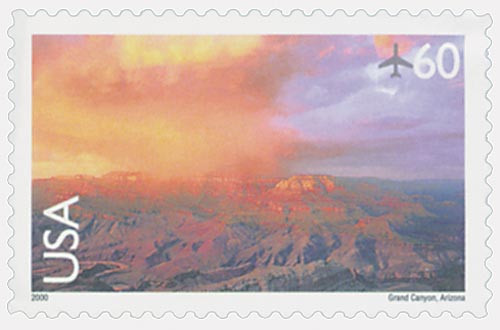
# C140 - 2006 75c Great Smoky Mnts Nat'l Park
Â
2006 75¢ Great Smokey Mountains
Scenic American Landscapes
Â
First City:Â St. Louis, Missouri
Quantity Issued: Â 100,000,000
Printed by: Â Ashton-Potter Ltd.
Printing Method: Lithographed
Perforation: Serpentine Die Cut 10 ¾Â
Great Smoky Mountains National ParkÂ
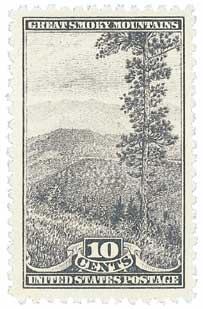
On June 15, 1934, Franklin Roosevelt signed legislation establishing Great Smoky Mountains National Park.
Native Americans were likely hunting in the Great Smoky Mountains as many as 14,000 years ago. Hernando de Soto and Juan Pardo were likely the first Europeans to visit the Smokies, in 1540 and 1567 respectively, passing through the French Broad River valley.
Europeans increasingly began exploring the Smokies during the mid 1700s. And following the French and Indian War (1754-63), tensions brewed between the native Cherokee and arriving white explorers. By the early 1800s, the Cherokee gave control of the Smokies to the U.S. government and 30 years later they would be removed along the Trail of Tears.
After the establishment of frontier outposts in the 1780s, permanent white settlers began arriving a decade later. In 1801, William and John Whaley became the first-known settlers in the park’s present-day Greenbrier section. The following year, William Ogle arrived and settled White Oak Flats. More people soon came and settled there, establishing the town that would later be known as Gatlinburg.
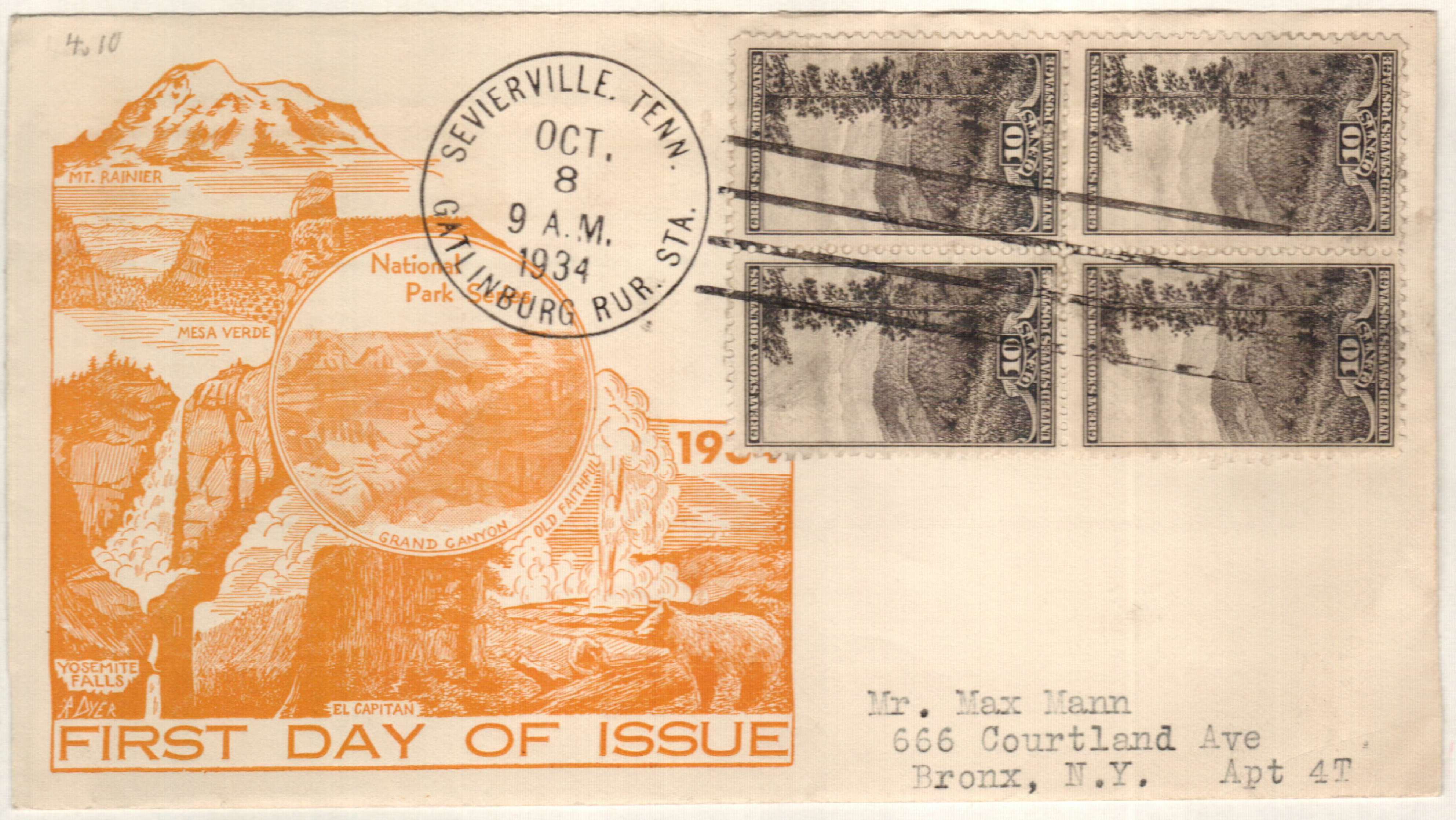
Throughout the 1800s, minor logging occurred in the Great Smoky Mountains. But the inaccessibility of the trees kept major operations out of the area for some time. However, when resources in the more accessible areas of the northeastern U.S. and Mississippi Delta were exhausted, entrepreneurs found ways to log the Smokies. By the 1880s, logging operations were using splash dams to float logs down rivers to lumber mills for processing. Many of these operations failed after a few years because floods destroyed their systems. But innovations in logging railroads followed, making it even easier for businesses to destroy the Smokies’ precious forest.
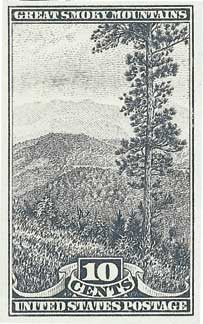
As logging companies cleared acres of forest, businessmen saw the Smokies as a tourist spot. Soon the Wonderland Hotel and Appalachian Club were established, drawing wealthy visitors from Knoxville to spend their summers at the mountain getaway. Among these visitors was businessman Colonel David Chapman. He, along with other members of the Appalachian Club, grew concerned over the state of the area and began lobbying for the Great Smoky Mountains to be protected as a National Park.
Chapman became head of the new Great Smoky Mountains Park Commission and began raising money to purchase land. He faced numerous obstacles in dealing with local, state, and Federal issues. Chapman had to convince logging companies to sell their lumber rights as well as purchase thousands of small farms and move entire towns. He faced further difficulties in dealing with the Tennessee and North Carolina governments, which often rejected the idea of spending taxpayer money on the proposed park. The first major victory came in 1926, when Congress authorized the park, but Chapman and his supporters had to raise the money to buy the land.
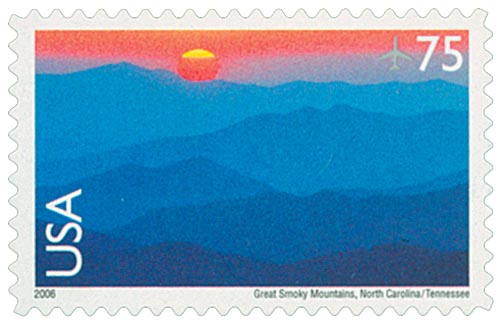
Chapman was not alone in his efforts. Several others promoted the idea through newspaper and magazine articles or negotiated for the lands. Though the odds seemed stacked against them, Chapman and his supporters succeeded in making almost all the major land purchases by 1932. Two years later, the park was officially created on June 15, 1934.
Â
Â
2006 75¢ Great Smokey Mountains
Scenic American Landscapes
Â
First City:Â St. Louis, Missouri
Quantity Issued: Â 100,000,000
Printed by: Â Ashton-Potter Ltd.
Printing Method: Lithographed
Perforation: Serpentine Die Cut 10 ¾Â
Great Smoky Mountains National ParkÂ

On June 15, 1934, Franklin Roosevelt signed legislation establishing Great Smoky Mountains National Park.
Native Americans were likely hunting in the Great Smoky Mountains as many as 14,000 years ago. Hernando de Soto and Juan Pardo were likely the first Europeans to visit the Smokies, in 1540 and 1567 respectively, passing through the French Broad River valley.
Europeans increasingly began exploring the Smokies during the mid 1700s. And following the French and Indian War (1754-63), tensions brewed between the native Cherokee and arriving white explorers. By the early 1800s, the Cherokee gave control of the Smokies to the U.S. government and 30 years later they would be removed along the Trail of Tears.
After the establishment of frontier outposts in the 1780s, permanent white settlers began arriving a decade later. In 1801, William and John Whaley became the first-known settlers in the park’s present-day Greenbrier section. The following year, William Ogle arrived and settled White Oak Flats. More people soon came and settled there, establishing the town that would later be known as Gatlinburg.

Throughout the 1800s, minor logging occurred in the Great Smoky Mountains. But the inaccessibility of the trees kept major operations out of the area for some time. However, when resources in the more accessible areas of the northeastern U.S. and Mississippi Delta were exhausted, entrepreneurs found ways to log the Smokies. By the 1880s, logging operations were using splash dams to float logs down rivers to lumber mills for processing. Many of these operations failed after a few years because floods destroyed their systems. But innovations in logging railroads followed, making it even easier for businesses to destroy the Smokies’ precious forest.

As logging companies cleared acres of forest, businessmen saw the Smokies as a tourist spot. Soon the Wonderland Hotel and Appalachian Club were established, drawing wealthy visitors from Knoxville to spend their summers at the mountain getaway. Among these visitors was businessman Colonel David Chapman. He, along with other members of the Appalachian Club, grew concerned over the state of the area and began lobbying for the Great Smoky Mountains to be protected as a National Park.
Chapman became head of the new Great Smoky Mountains Park Commission and began raising money to purchase land. He faced numerous obstacles in dealing with local, state, and Federal issues. Chapman had to convince logging companies to sell their lumber rights as well as purchase thousands of small farms and move entire towns. He faced further difficulties in dealing with the Tennessee and North Carolina governments, which often rejected the idea of spending taxpayer money on the proposed park. The first major victory came in 1926, when Congress authorized the park, but Chapman and his supporters had to raise the money to buy the land.

Chapman was not alone in his efforts. Several others promoted the idea through newspaper and magazine articles or negotiated for the lands. Though the odds seemed stacked against them, Chapman and his supporters succeeded in making almost all the major land purchases by 1932. Two years later, the park was officially created on June 15, 1934.
Â










